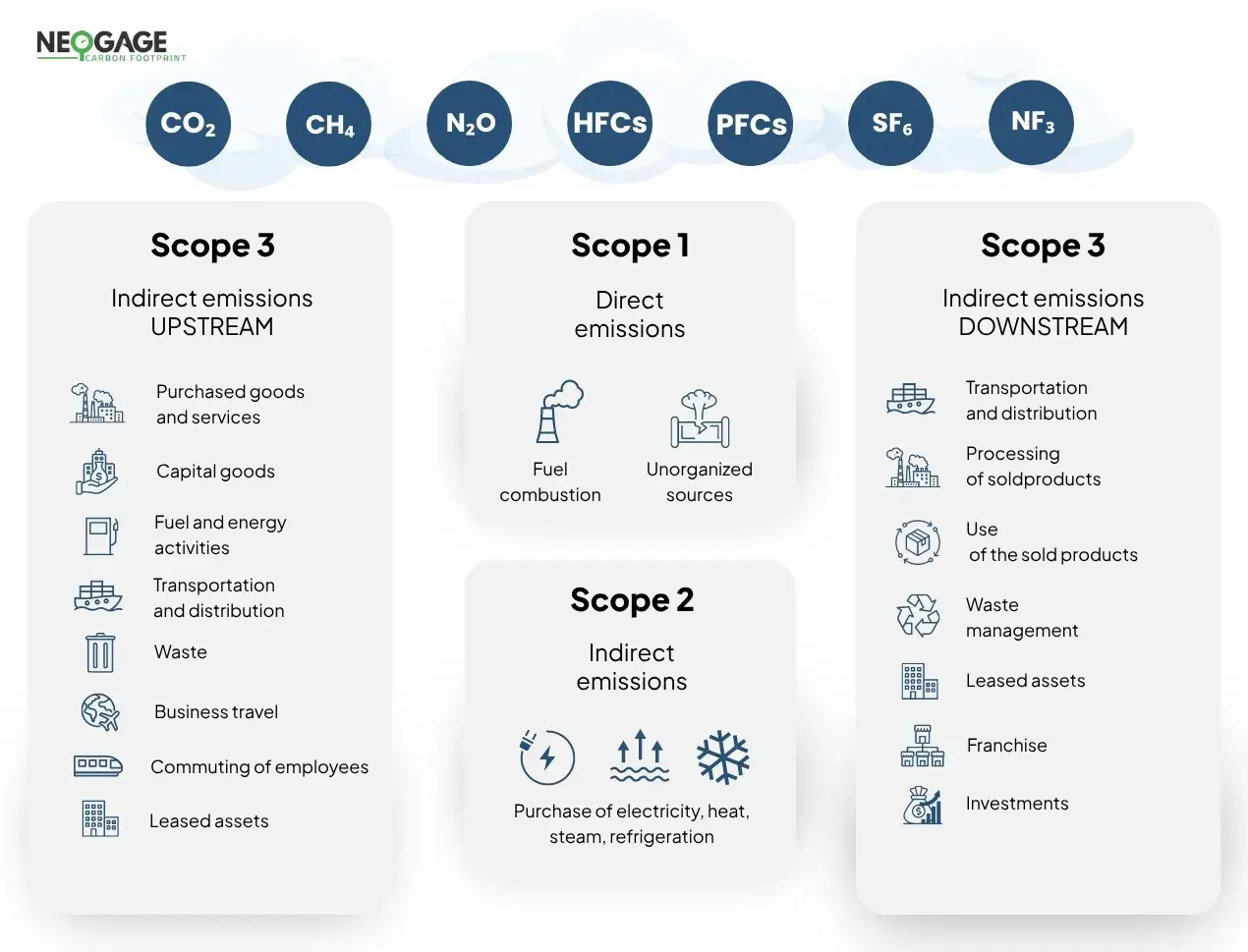GHG Protocol and ISO 14064: Key Standards in Greenhouse Gas Emissions Management
27 August, 2024
There is no denying that the topic of greenhouse gas (GHG) emissions management is becoming increasingly urgent and important in the context of global environmental protection efforts. The two most important standards that help organizations measure, report, and reduce emissions are the GHG Protocol and ISO 14064. Both play a key role in shaping sustainability strategies and meeting international climate commitments.

Table of Contents
- GHG Protocol: Global Framework for Emissions Management
- ISO 14064: International Standard for Verification and Reporting of Emissions
- ISO 14064-1: Specification and Quantitative Guidelines for Reporting Greenhouse Gas Emissions and Removals at the Organizational Level
- ISO 14064-2: Specification and Quantitative Guidelines, Monitoring, and Reporting of Emissions and Increasing Greenhouse Gas Removals at the Project Level
- ISO 14064-3: Specification and Guidelines for Verification and Validation of Greenhouse Gas Statements
- Emission Categories According to ISO 14064
- What benefits can the implementation of the GHG Protocol and ISO 14064 bring to your organization?
- Challenges and the Future
- Summary
GHG Protocol: Global Framework for Emissions Management
The GHG Protocol is the most widely used set of standards in the world for measuring, reporting, and managing greenhouse gas (GHG) emissions. Jointly developed by the World Resources Institute (WRI) and the World Business Council for Sustainable Development (WBCSD), the GHG Protocol provides companies, organizations, governments, and other entities with a framework for precise and consistent measurement of emissions and implementation of reduction strategies.
History and Background of the GHG Protocol
The GHG Protocol was developed in response to the growing needs of organizations for managing greenhouse gas emissions. It was first published in 2001, and its main goal was to provide companies with tools for measuring emissions in a uniform and comparable way worldwide. Since then, the GHG Protocol has become the foundation for many other standards and regulations, such as ISO 14064, the European Union Emissions Trading Scheme (EU ETS), as well as various programs within the UN framework.
Scopes of the GHG Protocol
The GHG Protocol defines three scopes of greenhouse gas emissions:
- Scope 1: Direct emissions from owned or controlled sources, e.g., emissions from production processes.
- Scope 2: Indirect emissions related to the consumption of purchased electricity, heat, and cooling generated outside the organization.
- Scope 3: Other indirect emissions resulting from the organization’s activities but emitted by other entities, e.g., transport, purchased raw materials, waste.

Thanks to the GHG Protocol, companies can report their emissions in a uniform and comparable way, which is crucial for the transparency and credibility of environmental data.
ISO 14064: International Standard for Verification and Reporting of Emissions
ISO 14064 is an international standard developed by the International Organization for Standardization (ISO), which provides guidelines for quantification, monitoring, reporting, and verification of greenhouse gas emissions. This standard is designed to help organizations manage their climate impact and meet GHG emissions reporting requirements. ISO 14064 consists of three parts, each with a different, specific application.
ISO 14064-1: Specification and Quantitative Guidelines for Reporting Greenhouse Gas Emissions and Removals at the Organizational Level
ISO 14064-1 is the first part of the standard and focuses on the principles and requirements for quantifying and reporting greenhouse gas emissions at the organizational level. Key elements of this part include:
- Scope of the standard: ISO 14064-1 covers all types of greenhouse gas emissions, both direct (Scope 1) and indirect (Scope 2 and Scope 3). The standard requires identification and quantification of emission sources within the organization and the creation of consistent and complete reports.
- Definitions and emission scopes: Organizations must clearly define which emissions are direct (from their own sources, e.g., fuel combustion in boilers) and which are indirect (e.g., emissions related to purchased electricity).
- Emission quantification: The standard provides guidelines on methods for quantifying emissions, including tools and formulas for accurate measurement or estimation of GHG emissions.
- Documentation and reporting: ISO 14064-1 requires detailed documentation of GHG emissions and regular reporting of this data. Reports should be complete, accurate, transparent, and consistent.
ISO 14064-2: Specification and Quantitative Guidelines, Monitoring, and Reporting of Emissions and Increasing Greenhouse Gas Removals at the Project Level
ISO 14064-2 is the second part of the standard, focusing on managing GHG emission reduction projects. This is a key part for organizations undertaking activities aimed at reducing their carbon footprint or increasing greenhouse gas removals, e.g., by planting trees.
- Quantification of emission reductions: The standard sets out the principles for quantifying emission reductions that may result from projects such as improving energy efficiency, using renewable energy sources, or technological changes.
- Project monitoring: ISO 14064-2 provides guidelines for monitoring and evaluating project outcomes. This allows ongoing tracking of whether projects are actually contributing to GHG emission reductions.
- Reporting results: The standard requires organizations to report the outcomes of their activities in a transparent and documented manner, which is essential for ensuring the credibility of achieved emission reductions.
ISO 14064-3: Specification and Guidelines for Verification and Validation of Greenhouse Gas Statements
ISO 14064-3 is the third part of the standard, focusing on the processes of verification and validation of GHG emission statements and reduction projects. This is a key tool for ensuring the credibility of reported data.
- Verification of GHG statements: The verification process involves an independent review and assessment of GHG emission data to ensure it complies with ISO 14064 requirements and accurately reflects reality.
- Project validation: Validation refers to the assessment of projects before their implementation to check whether they are designed in a way that is likely to deliver the expected emission reductions.
- Transparency and consistency: Verification and validation must be carried out according to clearly defined criteria, ensuring transparency, consistency, and reliability of assessments.
Emission Categories According to ISO 14064
In the context of the general principles of ISO 14064, we can distinguish six main emission categories that help organizations manage and report:
- Category 1: Direct emissions and removals of greenhouse gases
- Category 2: Indirect greenhouse gas emissions from imported energy
- Category 3: Indirect greenhouse gas emissions from transport
- Category 4: Indirect greenhouse gas emissions from products used by the organization
- Category 5: Indirect greenhouse gas emissions related to the use of the organization’s products
- Category 6: Indirect greenhouse gas emissions from other sources
What benefits can the implementation of the GHG Protocol and ISO 14064 bring to your organization?
Implementing the GHG Protocol and ISO 14064 brings a range of benefits to organizations:
- Increased transparency: A standardized approach to emission reporting builds trust among stakeholders, customers, and investors.
- Operational optimization: Emissions analysis allows identification of areas where cost reduction is possible through improved energy efficiency.
- Regulatory compliance: Many countries and regions are introducing increasingly stringent GHG emission regulations, and meeting international standards makes it easier to comply with these regulations.
- Market positioning: Companies that actively manage their emissions and report them in accordance with the GHG Protocol and ISO 14064 build their reputation as responsible and sustainable organizations.
How to report organizational emissions in accordance with the GHG Protocol and ISO 14064?
Learn more by watching our webinar:
or ask for a presentation of the NEOGAGE Carbon Footprint system features:
Challenges and the Future
Despite many benefits, implementing these standards can be challenging, especially for smaller companies that may not have sufficient resources. It also requires appropriate tools and competencies to accurately monitor and report emissions.
However, growing demands from markets and consumers, as well as tightening regulations, mean that the importance of the GHG Protocol and ISO 14064 will continue to grow. In the future, we can expect further development of these standards and their integration with other sustainability initiatives.
Summary
The GHG Protocol and ISO 14064 are the foundations for effective greenhouse gas emissions management. Their implementation is crucial for companies aiming for sustainable development, meeting international climate commitments, and building their market position. Thanks to these standards, organizations can not only reduce their negative environmental impact but also achieve numerous economic and social benefits, becoming leaders in the fight against global warming.